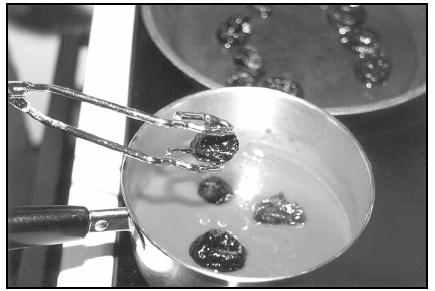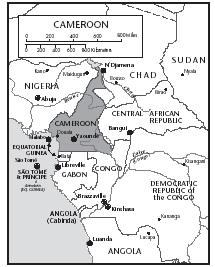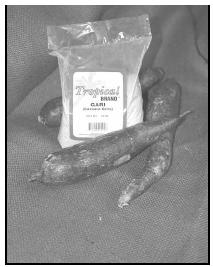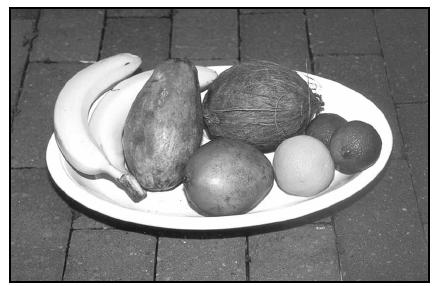History of Cameroonian Food
Many staples of the Cameroonian diet came from the explorers of the New World (the Americas). The Portuguese arrived in Cameroon in 1472 and brought with them such foods as hot peppers, maize (corn), cassava (a root vegetable), and tomatoes.
Other Europeans settled on the Came-roon coast in the mid 1800s, with the British arriving first, followed by the French and Germans. The French influence is reflected in the presence of some foods, such as omelets and French bread, as well as in the preparation of some dishes; however, for the most part, Cameroonians continue to prepare their own traditional foods.
Foreign restaurants can be found in the larger towns and cities of Cameroon. In 2001, the city of Doula boasted a number of Parisian-style cafes, Greek, Lebanese, and Chinese restaurants, as well as places offering pizza and hamburgers. Restaurants in

the capital city, Yaounde, also offered a variety of cuisines, including Chinese, French, Italian, Russian, and traditional Cameroonian food. In the smaller cities, street vendors and restaurants serve more traditional favorites than foreign dishes.
Safou a la Sauce Tomate (Prunes in Tomato Sauce)
Ingredients
- 12 prunes
- 1 cup water
- 2 cups tomato sauce
- 2 Tablespoons peanut oil
- 2 cups cooked rice
Procedure
- Rinse the prunes, cut them in half, and remove the pits.
- In a saucepan, simmer the prunes with water until soft, about 4 minutes. Drain.
- In a frying pan, heat the peanut oil over medium heat and fry the prunes, about 2 minutes.
- Measure the tomato sauce into a medium saucepan, and add the fried prunes.
- Cook over medium heat for 5 minutes. Serve over rice.
Serves 4 to 6.
3 FOODS OF THE CAMEROONIANS
The staple foods eaten by the people of Cameroon vary from region to region, depending on climate, and what is grown locally. In general, the Cameroonian diet is characterized by bland, starchy foods that are eaten with spicy (often very hot) sauces. Meat on skewers, fried and roasted fish, curries and peppery soups are common dishes.
Staple foods eaten in the north are corn, millet, and peanuts. In the south, people eat more root vegetables, such as yams and cassava, as well as plantains (similar to bananas). In both north and south regions, the starchy foods are cooked, then pounded with a pestle (a hand-held tool, usually wooden) until they form a sticky mass called fufu (or foofoo), which is then formed into balls and dipped into tasty sauces. The sauces are made of ingredients such as cassava leaves, okra, and tomatoes. The food most typical in the southern region of Cameroon is ndole, which is made of boiled, shredded bitterleaf (a type of green), peanuts, and melon seeds. It is seasoned with spices and hot oil, and can be cooked with fish or meat. Bobolo, made of fermented cassava shaped in a loaf, is popular in both the south and central regions.
Fresh fruit is plentiful in Cameroon. The native mangoes are especially enjoyed. Other fruits grown locally and sold in village marketplaces include oranges, papayas, bananas, pineapples, coconuts, grapefruit, and limes.

Easy Fufu
This is a good recipe to make with a friend, so you can share the job of stirring the stiff mixture and holding the pot steady. Neither the ingredients nor the process is authentic, but the results are similar in texture to the fufu prepared in Cameroon from cassava.
Ingredients
- 2½ cups instant flour mix (such as Jiffy Mix or Bisquick)
- 2½ cups instant mashed potato flakes
- 1 cup tapioca (made from cassava)
- 6 cups water

Procedure
- Bring the water to a boil in a large pot.
- Mix the instant flour mix, instant potato flakes, and tapioca together. Add the mixture to the boiling water, about 2 cups at a time. The mixture should be thicker and stiffer than mashed potatoes.
- Stir constantly for 10 to 15 minutes while the mixture continues to boil. (The mixture will become very thick and difficult to stir, but it is important that it be stirred continuously.)
- Let the mixture cool. Form the fufu into balls.
- Serve with a spicy stew or soup.
Serves 8 to 10.
Traditional Fufu
Ingredients
- 2 to 4 pounds (4 to 8 large) white or yellow yams (not sweet potatoes)
Procedure
- Scrub the yams. Place them in a large pot and cover them with water.
- Bring the water to a boil and cook for 20 to 30 minutes, until the yams are soft. (The skins will be easy to cut through with a fork or knife.)
- Drain yams into a colander, and run cold water over them to cool them.
- Remove peels from yams and return them to the pot.
- Using a potato masher or wooden spoon, mash and beat the yams for 10 to 15 minutes until completely smooth. (A helper can hold the pot steady while the yams are being beaten.)
- Shape the fufu into balls and serve with stew, sauce, or gravy.
Serves 8 to 10.
Ndole (Bitterleaf Soup)
Ingredients
- 2 cups dried bitterleaf (can substitute spinach, kale, collards, or turnip greens)
- ½ pound cooked shrimp (or one cup dried shrimp, if available)
- 1 cup natural-style peanut butter
- 1 large onion, chopped
- 2 cups water
- 2 Tablespoons fresh ginger, grated
- 2 cloves garlic, crushed
- 6 tomatoes, chopped
- 2 to 3 Tablespoons vegetable oil
- Salt and pepper, to taste
Procedure
- (If using any greens other than bitterleaf, skip this step.) Soak the bitterleaf overnight; drain in the morning and press out the excess water.
- If using kale, collards, or turnip greens, wash the greens, chop them, and cook them in a pot of boiling water for 5 minutes.
- If using spinach, wash the leaves and chop the spinach.
- Heat 2 Tablespoons of oil in a large pot and add the onions, garlic, and ginger. Sauté for 3 minutes.
- Add the chopped tomatoes, reduce heat, and simmer for about 3 minutes.
- Add the greens and simmer, stirring frequently, about 5 minutes.
- Add the peanut butter. Stir to combine well, cover the pot, and continue simmering until greens are tender (about 15 minutes). If mixture seems too dry, add water, ½ cup at a time.
- Cut shrimp into small pieces.
- Cook for 10 more minutes, then add the spinach.
- Serve with rice or boiled plantains and fufu.
Serves 6 to 8.

4 FOOD FOR RELIGIOUS AND HOLIDAY CELEBRATIONS
During the month long observance of the holiday of Ramadan, Cameroon's Muslims fast from dawn to dusk. This means they are forbidden to eat or drink during this time. The evening meal during Ramadan may include a rich soup. In most areas, a fete des mouton festival is celebrated two months after Ramadan to remember the willingness of Abraham to sacrifice a sheep from his flock. This celebration lasts for several days, during which it is customary for people to slaughter a sheep and then visit their friends and neighbors, giving them gifts of meat.
Most Cameroonians celebrate Christmas, even those who are not Christian. It is a time for visiting friends and family, and exchanging gifts. Holidays and events, such as coronations; saying goodbye to someone going abroad; weddings, and even funerals, are marked by feasts and meals at which friends and neighbors gather to eat local favorite dishes. It is traditional to slaughter and cook a sheep or goat at important occasions. Chicken dishes are also popular holiday fare.
Banana and Pineapple Salad
Ingredients
- 2 firm ripe bananas, peeled and sliced
- 2 firm ripe tomatoes, sliced
- 1 small pineapple, peeled and sliced
- 1 avocado, peeled, pitted, and sliced
- 1 Tablespoon roasted peanuts, chopped
- 1 can coconut milk
Procedure
- Boil the coconut milk until it thickens.
- Set it aside to cool.
- Pile the bananas, tomatoes, pineapple, and avocado alternately in layers in individual glass dishes.
- Top with chopped peanuts and the thickened coconut milk.
- Serve cold.
Serves 4 to 6.
5 MEALTIME CUSTOMS
At mealtime, damp towels may be passed out to diners (before and after the meal), to wash their hands; Cameroonians eat out of communal bowls. Using their right hands, they dip three fingers into the starchy food—often fufu or a millet dish—and then into the stews or sauces of the meal. It is customary for the men to serve themselves first, while the women wait patiently and the children eat what is left after the adults have finished.
People of Cameroon eat three meals a day. A variety of foods, including fruit, porridge, and boiled plantains, may be eaten for breakfast. Eggs and boiled cassava are also popular choices. Lunch and dinner are likely to feature a starchy dish such as fufu, boiled cassava, rice or millet, generally served with a vegetable soup or a hearty stew.
Meal preparation is very time consuming. Preparation of fufu, for example, can take days. The cassava or yams must be boiled and pounded into a pulpy mass. The preparation of fufu from powdered starch or rice is less complicated, but still requires much stirring. Cooking in the villages generally takes place over wood or charcoal fires, with iron pots and wooden spoons. In towns, canisters of propane may be used to power gas stoves. Even at the beginning of the twenty-first century electricity is seldom available for cooking use except in the largest cities.
Boiled Cassava
Ingredients
- 2 cassava
- Water
- 1 teaspoon salt
Procedure
- Wash the cassava, then peel off the thin white and brown skins.
- Cut the cassava into 3- to 4-inch long pieces.
- Cut each piece in two and remove the midrib.
- Place the cassava into a pot with enough water to cover the cassava half way. Add salt.
- Boil until the cassava is soft, but not falling apart.
- Drain and serve hot with fish or meat stew.
